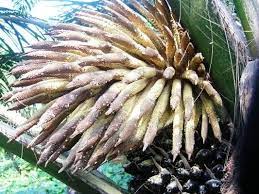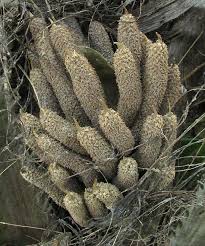Oil palm flowers are the reproductive structures of the oil palm tree (Elaeis guineensis). They play a crucial role in the production of oil palm fruits, which are harvested for their oil. The flowers are small and typically have a yellowish-green color. They grow in clusters on a long stalk called an inflorescence, which emerges from the axils of the oil palm fronds.
Oil palm flowers are classified into two main types: male and female flowers. The male flowers are borne at the upper portion of the inflorescence, while the female flowers are located at the lower portion. The male flowers consist of stamens, which are the male reproductive organs responsible for producing pollen. Each male flower has six stamens enclosed within a protective sheath called a calyx.
The female flowers are usually larger and more prominent than the male flowers. Each female flower consists of an ovary, which contains the ovules that can develop into seeds upon fertilization. The ovary is topped by three stigma lobes, which receive the pollen during pollination. Surrounding the ovary are six petals, forming a corolla, which are usually yellow or cream in color. The female flowers are also protected by a calyx, similar to the male flowers.
The oil palm flowers are pollinated primarily by insects, particularly beetles, bees, and weevils. These insects are attracted to the flowers by their sweet scent and nectar. Pollination occurs when the pollen from the male flowers is transferred to the stigma of the female flowers, allowing fertilization to take place. Once fertilized, the ovules develop into oil palm fruits, which contain a fleshy outer layer and a hard inner shell. The fruits mature over several months and are harvested for the extraction of palm oil.
Oil palm flowers are integral to the reproductive cycle of the oil palm tree and serve as the starting point for the production of oil palm fruits and subsequent palm oil extraction.
Economic Importance, Uses, and By-Products of Oil Palm Flowers

Oil palm flowers have several economic importance and uses. Here are some of them:
1. Production of Palm Oil: Oil palm flowers are crucial for the production of palm oil, which is widely used in various industries. The flowers contain both male and female reproductive parts. The female flowers develop into oil-bearing fruits, which are harvested and processed to extract palm oil. Palm oil is used in cooking, food processing, cosmetics, biofuels, and other industrial applications.
2. Palm Kernel Oil: The flowers of the oil palm also produce palm kernel oil. Palm kernel oil is extracted from the seeds found within the oil-bearing fruits. It is commonly used in the food industry, particularly in the production of confectionery, margarine, and various baked goods. It is also used in the manufacturing of soaps, detergents, and personal care products.
3. Medicinal and Traditional Uses: Oil palm flowers have been used in traditional medicine for various purposes. They are believed to have medicinal properties and are used in remedies for treating ailments such as diarrhea, fever, and wounds. Additionally, oil palm flowers are used in traditional rituals and ceremonies in some cultures.
4. Animal Feed: After the extraction of palm oil and palm kernel oil, the remaining pulp and fibers from the oil palm fruits can be used as animal feed. These by-products, known as palm kernel cake or palm meal, are rich in protein and can be utilized as a supplementary feed for livestock, such as poultry, cattle, and pigs.
5. Organic Fertilizers: The oil palm flowers, along with other parts of the palm tree, can be composted and used as organic fertilizers. The nutrient-rich compost helps improve soil fertility, enhances plant growth, and increases crop yield. This is particularly beneficial for small-scale farmers who practice sustainable agriculture.
6. Ornamental Purposes: Oil palm flowers are aesthetically appealing and can be used for ornamental purposes. They are often included in floral arrangements, decorations, and landscaping projects to add beauty and visual interest.
7. Honey Production: Oil palm flowers produce nectar, which is collected by bees and used to produce palm honey. Palm honey is a sweet and flavorful natural product that is consumed as a food item and used in culinary preparations.
8. Beauty and Cosmetics Industry: Oil palm flowers are a source of tocotrienols and tocopherols, which are forms of vitamin E. These compounds are used in the beauty and cosmetics industry for their antioxidant properties. They are incorporated into skincare products, haircare products, and cosmetics to provide moisturizing and anti-aging benefits.
9. Essential Oil Extraction: Oil palm flowers can be used for the extraction of essential oils. The oil extracted from the flowers possesses a pleasant aroma and is used in the production of perfumes, scented candles, soaps, and other aromatic products.
10. Biomass Energy: The oil palm flowers, along with other residues from oil palm processing, can be utilized as biomass for energy generation. The flowers can be converted into biogas or used as feedstock for biomass power plants, providing a renewable energy source.
Read Also : Economic Importance, Uses, and By-Products of Oil Palm Inflorescence
11. Biodiversity and Ecological Benefits: Oil palm flowers are a crucial component of the oil palm ecosystem, attracting pollinators such as bees and insects. These flowers support biodiversity by providing food and habitat for various insects and animals. The presence of oil palm flowers contributes to maintaining a balanced ecosystem within oil palm plantations.
12. Job Creation and Economic Development: The cultivation, processing, and utilization of oil palm flowers contribute to job creation and economic development in regions where oil palm is grown. It supports employment opportunities in farming, harvesting, processing, and various related industries, providing livelihoods for local communities.
Overall, oil palm flowers play a vital role in the production of palm oil and palm kernel oil, contribute to traditional medicine and rituals, serve as animal feed and organic fertilizers, have ornamental value, and contribute to honey production. These diverse uses make oil palm flowers economically significant in various industries and communities.
It is important to note that while oil palm flowers have numerous economic uses, the production of palm oil and its environmental impact has generated debates regarding sustainability, deforestation, and biodiversity loss. Sustainable practices and responsible management are crucial to mitigate these concerns and ensure a balance between economic benefits and environmental preservation.
The Products and By-products That Can Be Derived From Oil Palm Flowers

Oil palm flowers, also known as inflorescences, are a valuable part of the oil palm tree that can be utilized to produce several products and by-products. Here are some examples of the products and by-products derived from oil palm flowers:
1. Palm Oil: The primary product derived from oil palm flowers is palm oil. The flowers contain a high concentration of oil-rich tissues, which are processed to extract palm oil. Palm oil is a versatile edible oil used in cooking, food processing, and various industries.
2. Palm Kernel Oil: Along with palm oil, oil palm flowers also yield palm kernel oil. Palm kernel oil is obtained from the seeds within the oil palm fruits. It is widely used in the food industry, especially in confectionery, bakery, and margarine production.
3. Palm Kernel Cake: After extracting the palm kernel oil, the remaining seed cake is known as palm kernel cake. It is a valuable by-product used as animal feed due to its high protein content. Palm kernel cake is commonly used in the livestock and poultry industries.
4. Palm Wine: The sap extracted from the oil palm flowers is fermented to produce palm wine. Palm wine is a traditional alcoholic beverage popular in some regions. It is consumed both as a refreshing drink and as a base for distilling local spirits.
Read Also : Economic Importance, Uses, and By-Products of Oil Palm Fronds
5. Palm Sugar: The sap obtained from oil palm flowers can be further processed to produce palm sugar. The sap is boiled until the water content evaporates, leaving behind a sweet syrup, which solidifies into palm sugar. Palm sugar is used as a natural sweetener in various culinary applications.
6. Palm Vinegar: By fermenting the sap from oil palm flowers, palm vinegar can be obtained. It is a tangy and acidic liquid commonly used in cooking, salad dressings, and pickling.
7. Bioethanol: Oil palm flowers can serve as a source for the production of bioethanol, a renewable fuel. Through fermentation and distillation processes, the sugars present in the flowers can be converted into ethanol, which can be blended with gasoline or used as a standalone fuel.
8. Fertilizer: The leftover biomass from oil palm flowers can be utilized as organic fertilizer. The biomass, known as empty fruit bunches (EFB), can be composted or processed to release valuable nutrients for agricultural purposes.
9. Animal Feed: In addition to palm kernel cake, the fibrous biomass of oil palm flowers, such as the EFB mentioned earlier, can be used as animal feed. The fibrous material can be processed into pellets or utilized as a roughage component in livestock diets.
10. Organic Mulch: The fibrous residues from oil palm flowers can be shredded and used as organic mulch in agriculture and gardening. Mulching helps retain moisture in the soil, suppresses weed growth, and improves soil structure.
11. Essential Oils: Oil palm flowers can be steam-distilled to extract essential oils. These oils are used in aromatherapy, perfumery, and cosmetic products. Oil palm flower essential oil is known for its pleasant floral scent and may have therapeutic properties.
12. Biomass Energy: The fibrous residues of oil palm flowers, such as empty fruit bunches (EFB), can be used as a source of biomass energy. EFB can be processed into pellets or briquettes and burned as fuel in biomass power plants or industrial boilers, generating electricity or heat.
13. Natural Dye: Oil palm flowers contain pigments that can be extracted and used as natural dyes. These dyes can be employed in the textile industry, artisanal crafts, and dyeing fabrics.
14. Traditional Medicine: In certain traditional medicine practices, various parts of the oil palm flower, such as the sap, inflorescence, or roots, are used for medicinal purposes. They are believed to possess medicinal properties and may be used to treat ailments or as herbal remedies.
15. Potpourri: The dried oil palm flowers can be used to make potpourri, a mixture of dried flowers, herbs, and spices that emit a pleasant fragrance. Oil palm flower petals add a unique floral scent to potpourri blends.
16. Animal Bedding: The fibrous biomass of oil palm flowers, including empty fruit bunches (EFB), can be processed and used as animal bedding material. It provides comfort and absorbs moisture in animal housing, particularly in livestock and poultry farms.
17. Paper and Pulp: The fibrous residues of oil palm flowers, such as empty fruit bunches (EFB) or palm fronds, can be processed into pulp and used in the production of paper and paper products.
18. Mushroom Cultivation Substrate: Oil palm flower residues, such as the fibrous biomass, can serve as a substrate for growing certain types of mushrooms. The biomass provides a nutritious and sterile medium for mushroom cultivation.
19. Biogas: The anaerobic digestion of oil palm flower residues, such as empty fruit bunches (EFB), can generate biogas. Biogas is a renewable energy source that can be used for cooking, heating, or generating electricity.
20. Organic Soil Amendment: Oil palm flower residues, when composted or processed, can be used as an organic soil amendment. They enrich the soil with organic matter, improve its structure, and enhance nutrient availability for plant growth.
These examples demonstrate the diverse range of products and by-products that can be derived from oil palm flowers, highlighting their potential applications in various industries and sectors.
Read Also : How to Find Investors for House Flipping
